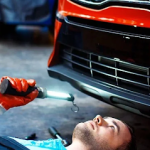In the course of motorcycle maintenance, one task that often gets overlooked is bleeding the brakes. Yet, this process is crucial for the efficient and safe operation of your bike. For those of you who ride a Triumph Rocket III, you may wonder how exactly to go about this task. In this article, we will cover the step-by-step process of bleeding your brakes correctly, ensuring your next ride is as smooth and secure as possible.
Preparation: Understanding the Basics of Brake Systems
Before we delve into how to bleed brakes, let’s take a moment to understand the basic components of the brake system. The brake system of a Triumph Rocket III, like any other motorcycle, essentially comprises the brake lever, master cylinder, brake fluid reservoir, brake line, and the calipers.
This might interest you : What are the guidelines for wiring a new tail light on a Honda CB650R?
When you press down on the brake lever, it activates the master cylinder, which then pushes brake fluid from the reservoir through the brake lines. This fluid movement forces the calipers to clench onto the disc, bringing your bike to a stop. Over time, air can get trapped in the brake lines and hinder the effective transfer of pressure from the master cylinder to the calipers. Bleeding the brakes will remove this air, restoring your brake system to its optimal operating condition.
Step 1: Gather Your Tools and Safety Gear
Before you begin, ensure you have all the necessary tools and safety equipment. You’ll need brake fluid, a container to catch the old fluid, a wrench to open the bleed valve, a brake bleeder kit if available, and a clear plastic hose. Safety gear would include gloves and safety glasses. Also, make sure you’re conducting this procedure in a well-ventilated area as brake fluid can be harmful if inhaled or ingested.
This might interest you : Transform your ride with modern graphics kits available now
Step 2: Locate the Bleeder Valve and Prepare to Bleed the Brakes
The bleeder valve is typically located on the caliper. It’s a small nut with a tiny hole through its center which allows brake fluid to be expelled when the valve is open. To prepare for bleeding, first, ensure that the brake fluid reservoir is topped up with new fluid. Secure the clear plastic hose to the bleeder valve and place the other end into the catch container.
Step 3: Bleeding the Master Cylinder
Begin the bleeding process by pumping the brake lever several times and holding it down to create pressure in the brake system. While maintaining pressure on the lever, open the bleeder valve using your wrench. You will see old fluid and air bubbles start to move through the clear hose into the catch container. Close the bleeder valve before releasing the brake lever to avoid drawing air back into the system.
Step 4: Repeat the Process until all Air is Expelled
Repeat step 3 until you no longer see air bubbles in the expelled fluid. Be sure to check the fluid level in the reservoir continually and top it up as needed to avoid drawing air into the system. When no more air bubbles are visible, close the bleeder valve, remove the tube and refill the reservoir to the appropriate level.
Step 5: Bleeding the ABS System
If your Triumph Rocket III is equipped with an ABS (Anti-lock Brake System), you will need to bleed this part of the brake system as well. The ABS module, which prevents wheel lock-up during braking, can also accumulate air over time. To do this, you will have to repeat steps 3 and 4, but this time with the ABS pump activated. Consult your bike’s manual or visit a professional shop for further directions on this step, as some ABS systems may require specific procedures.
Remember, bleeding your brakes is an essential aspect of motorcycle maintenance. It may seem daunting at first, but with a little practice, you will be able to do it with ease. So, next time you feel your brakes becoming spongy or notice a decreased braking performance, don’t hesitate to bleed your brakes. Your Triumph Rocket III will thank you for it.
Tips and Precautions for Bleeding Brakes
Knowing the steps on how to bleed brakes is just half the battle. As a responsible Triumph Rocket III owner, you should also know the precautions to take and the tips to follow to make the bleeding process easier and safer.
Firstly, always wear safety glasses and gloves when working with brake fluid. This substance is corrosive and can cause harm to your eyes and skin. Also, make sure your work area is well-ventilated as brake fluid fumes are harmful if inhaled.
Use a wrench that fits the bleed valve or bleed nipple properly. Using the wrong size could result in a rounded-off bleed valve and will make the job much more difficult.
Make sure that the brake fluid reservoir never runs dry during the bleeding process. If it does, air will be drawn back into the brake system and you’ll have to start all over again.
Bleeding the brakes is a slow process. Rushing it will only result in a poorly done job and you might still end up with air in your brake system. Take your time and be patient.
If your Triumph Rocket III has an ABS system, bleed it as well. The dealer tool or motorcycle’s manual can guide you on how to do this.
Finally, if after several attempts at bleeding your brakes you still feel that your braking performance has not improved, it would be best to seek professional help. Your brake system might need more extensive work, like using rebuild kits or performing a reverse bleed.
Conclusion: The Importance of Regularly Bleeding Brakes on Your Triumph Rocket III
In conclusion, bleeding brakes is an essential part of maintaining your Triumph Rocket III. It ensures optimal brake performance and, therefore, your safety on the road.
The process may seem intimidating initially, but with practice, it becomes a routine task. The key is understanding the function of each part of the brake system, including the master cylinder, brake lever, fluid reservoir, and bleeder valve.
Bleeding brakes is not just about following the steps. It also involves taking necessary precautions, like wearing safety gear and ensuring the brake fluid reservoir does not run dry. It requires patience, as rushing the bleeding process can result in a shoddy job and compromised brake performance. And if your bike has an ABS system, it needs to be bled as well.
If all else fails, don’t risk your safety by persisting with poor brakes. Seek professional help.
So, remember to bleed your brakes regularly. Your Triumph Rocket III will perform better, and your rides will be safer and more enjoyable.












